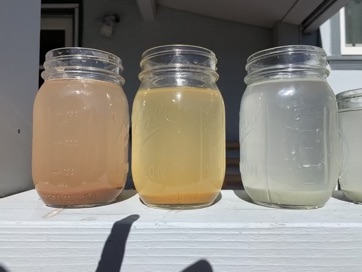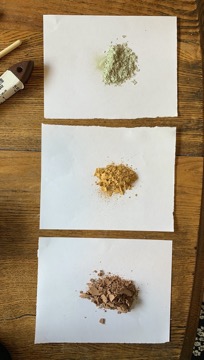Pigments from the Morrison Formation
In this installment, I attempt to make some of the most common and basic pigments available to ancient artisans using colorful dirt, coffee filters, and various containers. The Ancient Egyptians had a surprisingly limited color palette. The most common colors were red, yellow, black and white. Black came from soot and white usually came from chalk or gypsum. (Scott 2016, Quirke and Lee 2000)
Blue and Green were usually variants on Egyptian blue. These were manufactured in a fairly labor intensive process. These colors along with the orangey-red Realgar and the sparkling yellow Orpiment would be considered “premium colors” in today’s parlance. (Cooney, 2007, 217) They were hard to get, and considering that the last two were arsenic sulphates and didn’t occur in the Nile valley, they were dangerous to get as well (Colinart 2001 discusses likeley sources for Orpiment)
The “ordinary” wealthy Egyptians who could afford painted goods got much use from red and yellow ochre. These usually consist of clays with large amounts of iron oxides in them. (Colinart, 2001) They are and were easy to obtain and process to make pigment, and the reds and yellows that they produce can be very vivid depending on the source.
I wanted to try to make some red and yellow ochre pigment myself, but unfortunately, the dirt in my area tends to be kind of an ashy brown, and the rocks tend to be gray and hard. (You can tell here that I have no background in Geology and only slightly more in Chemistry). Happily for this little experiment, my parents live in an area where there is a lot of multi-colored sandstone--part of Eastern Utah and Western Colorado's Morrison Formation. Here, it would just be a matter of finding the greenest, yellowest or reddest spot to grab a handful of sand and rocks. Which I did.
 I would be remiss here if I did not mention that the native inhabitants of Eastern Utah and Western Colorado, specifically the Utes and the Fremont Culture, have used local ochres in this area for pigments for thousands of years. While I admire the rock art in this area, I don't consider myself knowledgeable about their beleifs or qualified to talk about their practices. I assume that the filtration techniques that they used would be roughly the same as what the Egyptians used, and roughly the same as what I used--minus the modern conveniences.
I would be remiss here if I did not mention that the native inhabitants of Eastern Utah and Western Colorado, specifically the Utes and the Fremont Culture, have used local ochres in this area for pigments for thousands of years. While I admire the rock art in this area, I don't consider myself knowledgeable about their beleifs or qualified to talk about their practices. I assume that the filtration techniques that they used would be roughly the same as what the Egyptians used, and roughly the same as what I used--minus the modern conveniences.
To start processing my pigment, I did not need to grind it up much. In some places, the ochre occurs in rocks that are more clay-ey or hard. If you live in such an area, you might have to put some work into grinding up the rocks. The sand I got was eroding sandstone, so it was powdery already. I did give it a quick grind in my mortar and pestle just to break up the larger bits. The result was colorful but sandy, so the next step was to filter that out.
I spooned two or three tablespoons of colored sand into a mason jar for each color, and filled the mason jar, stirring the contents. Within a very short time, the sand started to settle on the bottom, but the water was still clouded with pigment. At this point, I carefully poured off the colored water into another mason jar to save, and I discarded the sand in the bottom. I did this two or three times, until most of the material heavy enough to settle on the bottom of the jar within a minute was gone.
 By this point, I had three jars of pigment in suspension. Red, yellow, and green. All the sand was gone. I let these sit outside uncovered overnight, and by the morning, the water was clear and all of the pigment had settled on the bottom.
By this point, I had three jars of pigment in suspension. Red, yellow, and green. All the sand was gone. I let these sit outside uncovered overnight, and by the morning, the water was clear and all of the pigment had settled on the bottom.
The first filtration removed the sand, but there were still sticks and bugs floating on the top of some of my jars. So, I carefully poured about half of the water out of each jar, discarding it and trying very hard not to dump out much of the pigment on the bottom, which was very quick to re-suspend. Then, I emptied the contents of the jars into wider dishes. And left them in a safe place to evaporate. When the contents of each dish was only a few tablespons of water, I scraped the contents onto coffee filters and allowed the material on the coffee filter to dry. No fancy chemistry equipment here! I used a palette knife to scrap the resulting powder off of the coffee filters.
Here, you can see the resulting pigments—the red is more pink than I would have expected from the color of the sand, but the yellow is a nice rich mustardy yellow.
 I don’t know what to make of the green. It looked very green on the ground, and almost white in suspension. Now it’s back to being a chalky green color. I have no idea what is in it—chemistry was never really my strong point. Maybe it is an iron containing compound, since I found it close to the red and the yellow. Green Earth would be interesting and relevent to this because it started to replace synthetic Egyptian green on coffins after the Third Intermediate Period (Scott, 2016, p 196). The green it makes is more of an army green color than the lush blue-green of Egyptian Green. It will be interesting to see how my green looks on paper given that it was almost white when in solution.
I don’t know what to make of the green. It looked very green on the ground, and almost white in suspension. Now it’s back to being a chalky green color. I have no idea what is in it—chemistry was never really my strong point. Maybe it is an iron containing compound, since I found it close to the red and the yellow. Green Earth would be interesting and relevent to this because it started to replace synthetic Egyptian green on coffins after the Third Intermediate Period (Scott, 2016, p 196). The green it makes is more of an army green color than the lush blue-green of Egyptian Green. It will be interesting to see how my green looks on paper given that it was almost white when in solution.
Anyway, it’s been a while since I last updated this—I’ve been deep in dissertation land. However, I hope this little post at least gave you some pretty pictures to enjoy. This is an easy project that is fun to do, and which you could probably do with kids if you have a good source of yellow and red ochres in your area.
Bibliography & Further Reading:
- Colinart, Sylvie, ‘Analysis of Inorganic Yellow Colour in Ancient Egyptian Painting’, in Color and Painting in Ancient Egypt, ed. by W. V. Davies (London: The British Museum Press, 2001), pp. 1–9
- Cooney, Kathlyn M., The Cost of Death, Egyptologische Uitgaven (Leiden: Nederlands Instituut voor het Nabije Oosten, 2007)
- Quirke, Stephen, and Lorna Lee, ‘Painting Materials’, in Ancient Egyptian Materials and Technology, ed. by Paul T. Nicholson and Ian Shaw (Cambridge ; New York: Cambridge University Press, 2000), pp. 104–21
- Scott, David A., ‘A Review of Ancient Egyptian Pigments and Cosmetics’, Studies in Conservation, 61.4 (2016), 185–202 <https://doi.org/10.1179/2047058414Y.0000000162>
Finally, I based this little experiment on this video on how to filter ochre pigments by The Alchemical Arts. His videos are relaxing, entertaining, and given the stuff he does in his backyard, I’d be nervous if I was his neighbor.
Alchemical Arts, Ochre Pigments | Part 1: Preparation of Earth Colours (Melbourne, Australia, 2014) https://youtu.be/LKGsQxv72AA [accessed 1 November 2020]
Hi, Dad!
Also, a shoutout to my dad, who is always up for an adventure, even if that adventure turns out to be driving around and collecting dirt.
